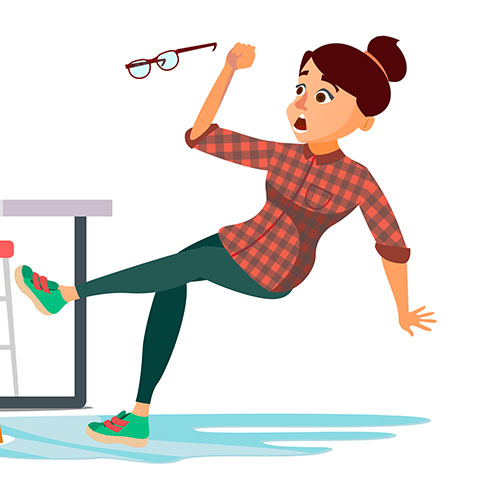
Fall prevention tips. Photo: Deposit Photos
In older adults, the risk of a fall injury rises substantially in the month before a hospitalization and remains elevated after discharge, a University of Michigan study found.
The findings suggest that if fall prevention measures were implemented earlier and across care settings—home, nursing home, rehab, hospital—trained professionals could uncover these underlying illnesses before they become so serious that they require hospitalization.
“By the time someone’s in the hospital, we’ve missed signs of deteriorating health,” said Geoffrey Hoffman, assistant professor at the U-M School of Nursing and principal investigator on the study. “And, by ignoring needs for rehabilitation and recovery after hospitalization, we are allowing risk to accrue and remain for the most vulnerable patients.”
Hoffman and colleagues wanted to know if falls increased or decreased for adults in the six months before and after a hospitalization. The national study included data for patients 65 and older who were hospitalized for a reason besides a fall.
They found that fall risk jumps about 33% per week in the month before hospitalization. This spike is much higher (310% per week in the month prior to hospitalization) for patients who also fell while in the hospital. For those patients, risk decreases only 4% per week after discharge.
One of the big implications of the findings is that patients bring a lot of fall risk into the hospital, and so it’s even more imperative that hospitals provide better in-hospital as well as discharge fall-prevention efforts, Hoffman said. Although fall injuries are among the costliest diagnoses in Medicare, little has been done to partner hospitals with other care providers along the care continuum, he said.
“We know that care coordination is critical for helping patients manage risk. But when it comes to falls—a primary indicator of function—our system typically interacts with patients after an injury and isn’t broadly successful at managing risk proactively or longer term, or assigning interdisciplinary teams to patients moving through various parts of the health care system.”
Falls can be fatal for older adults. Every year, about one-third of older Americans fall, and 10%-15% are injured. Both fatal and nonfatal injuries are up, and will likely keep rising given the burgeoning older adult population, Hoffman said. Medicare spends $15 billion to $35 billion annually on fall injury treatment.
Fall risk naturally increases with age but that doesn’t have to mean a loss of independence, Hoffman said. With preparation, older adults and caregivers can reduce risk and negative outcomes associated with falls.
“All activities come with risk, and it’s important to maintain independence,” Hoffman said. “The best way to do that is to be cognizant of fall risks—environmental safety hazards, issues with mobility—and, if comfortable, aim to do something about them. Find a yoga class, work on muscle strengthening and flexibility.”
Not all falls are dangerous, and families can help determine the proper tradeoff between risk and independence, he said.
“It might be worth being more active even if fall risk slightly increases, as long as the older adult is comfortable with that risk,” he said.
The study, “Pre-hospital and post-hospital fall injuries in older US adults,” appears in JAMA Network Open.
How to Prevent Falls
The National Institute on Aging (NIA) offers these ways to prevent falls.
If you take care of your overall health, you may be able to lower your chances of falling. Most of the time, falls and accidents don’t “just happen.” Here are a few tips to help you avoid falls and broken bones:
Stay physically active.
Plan an exercise program that is right for you. Regular exercise improves muscles and makes you stronger. It also helps keep your joints, tendons, and ligaments flexible. Mild weight-bearing activities, such as walking or climbing stairs, may slow bone loss from osteoporosis.
Have your eyes and hearing tested.
Even small changes in sight and hearing may cause you to fall. When you get new eyeglasses or contact lenses, take time to get used to them. Always wear your glasses or contacts when you need them If you have a hearing aid, be sure it fits well and wear it.
Find out about the side effects of any medicine you take.
If a drug makes you sleepy or dizzy, tell your doctor or pharmacist.
Get enough sleep.
If you are sleepy, you are more likely to fall.
Limit the amount of alcohol you drink.
Even a small amount of alcohol can affect your balance and reflexes. Studies show that the rate of hip fractures in older adults increases with alcohol use.
Stand up slowly.
Getting up too quickly can cause your blood pressure to drop. That can make you feel wobbly. Get your blood pressure checked when lying and standing.
Use an assistive device if you need help feeling steady when you walk.
Appropriate use of canes and walkers can prevent falls. If your doctor tells you to use a cane or walker, make sure it is the right size for you and the wheels roll smoothly. This is important when you’re walking in areas you don’t know well or where the walkways are uneven. A physical or occupational therapist can help you decide which devices might be helpful and teach you how to use them safely.
Be very careful when walking on wet or icy surfaces.
They can be very slippery! Try to have sand or salt spread on icy areas by your front or back door.
Choice of shoes.
Wear non-skid, rubber-soled, low-heeled shoes, or lace-up shoes with non-skid soles that fully support your feet. It is important that the soles are not too thin or too thick. Don’t walk on stairs or floors in socks or in shoes and slippers with smooth soles.
Always tell your doctor if you have fallen since your last checkup, even if you aren’t hurt when you fall. A fall can alert your doctor to a new medical problem or problems with your medications or eyesight that can be corrected. Your doctor may suggest physical therapy, a walking aid, or other steps to help prevent future falls.









